Participants: Stefan Esders (Berlin), Sarah Greer (St Andrews), Sarah Hamilton (Exeter), Alice Hicklin (Berlin), Simon MacLean (St Andrews), Ekaterina Novokhatko (Barcelona), Lenneke van Raaij (Exeter), Matthias M. Tischler (Barcelona), Jelle Wassenaar (Vienna)
Philippe Depreux (Hamburg), Sumi Shimahara (Paris), Charles West (Sheffield)
This synergy event allowed scholars to investigate several important manuscripts located in Catalan archives and libraries, exploring the rich legacy of early medieval Catalonia. This was part of the preparation of a bilingual (English and Catalan) album of essays on selected manuscripts of Carolingian text culture in Catalan libraries and archives, which is to be published in 2019.
Thursday May 24th
Location: Arxiu de la Corona d’Aragó
Presentations by: Charles West, Philippe Depreux, Stefan Esders, Matthias M. Tischler, Ekaterina Novokhatko.
The presenters were invited to study the manuscripts in the morning, before giving a presentation to the rest of the audience in the early afternoon.
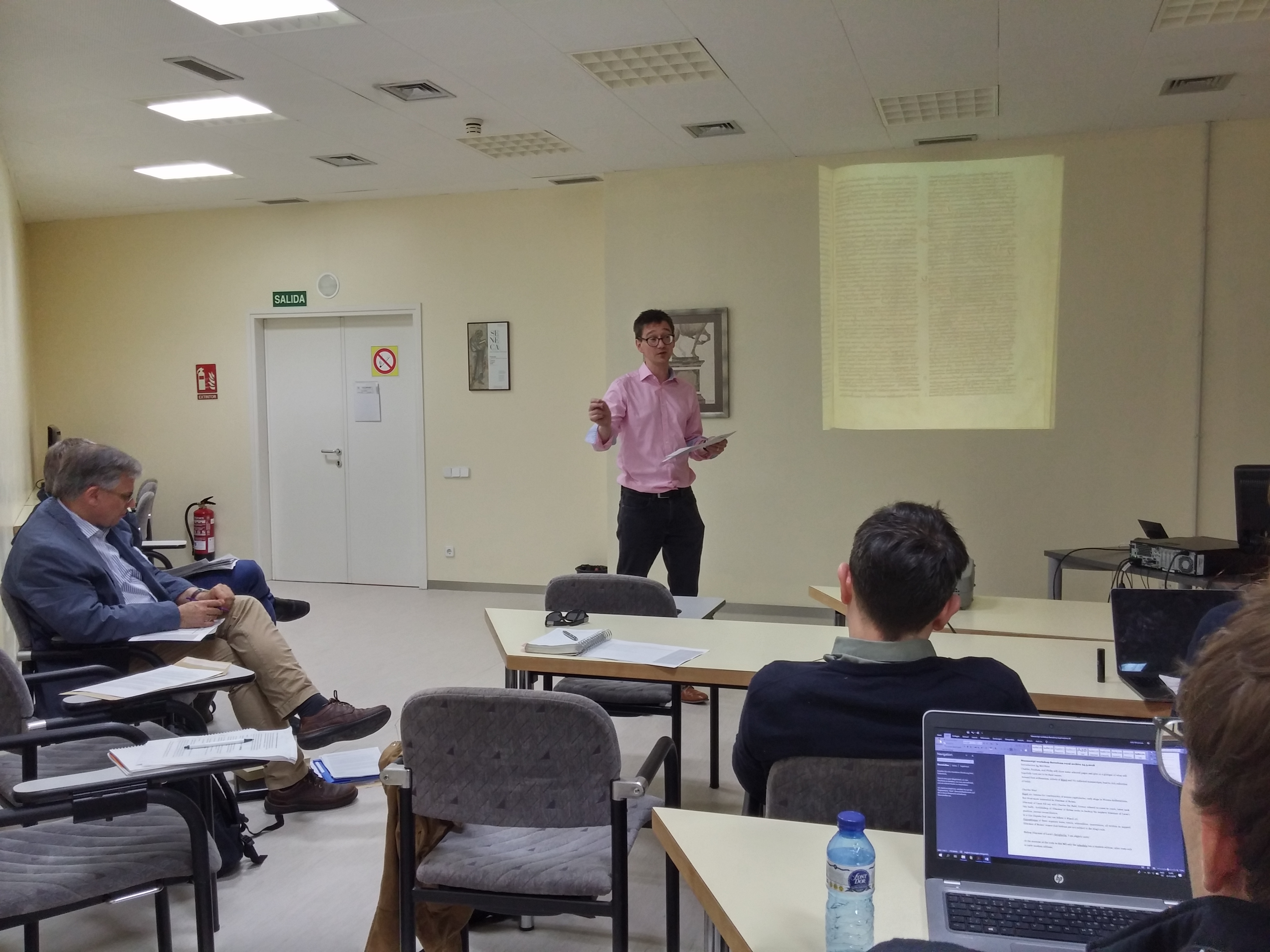
Charles West looked at the manuscript Barcelona, ACA, Ms. Ripoll 40. In addition to several important collections of Carolingian capitularies, it contains a selection of works by Hincmar of Reims and his nephew Hincmar of Laon, concerning the question of whether bishops should answer to the king or be goverened by ecclesiastical law. These texts were initially written in the context of Hincmar of Laon’s conflict with Charles the Bald in 868/869. In 868, Hincmar was accused of having treated some of his vassals unjustly and the king demanded he defend himself before a secular court. The bishop of Laon, supported by his uncle, refused to appear before the king’s judges, sparking a year-long conflict. West noted that one of the texts in the Ripoll MS, Hincmar of Reims’ rotula, is shorter than the version of the text found in two other manuscripts. He argued that the text transmitted in Ripoll 40 is not an incomplete or “faulty” version of the rotula, but an edition of Hincmar’s work that he sent out before he added further additions to the text in other manuscripts kept in Reims.
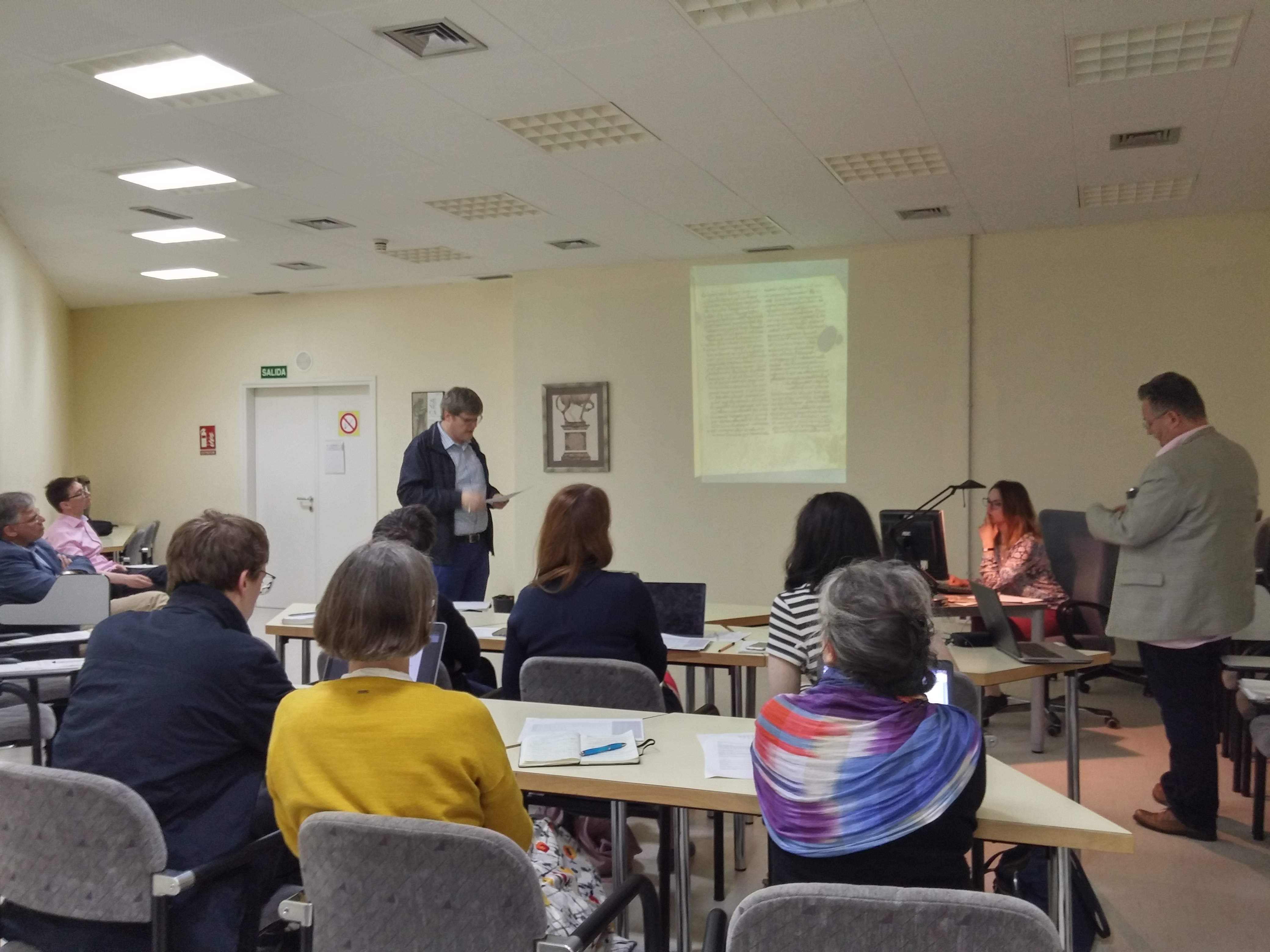 Philippe Depreux discussed a schoolbook of rather poor quality (Barcelona, ACA, Ms. Ripoll 74). The manuscript dates to the tenth or early eleventh century and consists of three parts bound together in the twelfth century at the latest. It contains formularies, glossaries, as well as several miscellaneous scribbles and songs with neums. The manuscript is most famous for its collection of carmina, or love songs. The poor condition of the manuscript is perhaps best exemplified by a single page on which the scribe started copying down a definition from Isidore’s Etymologies: the scribe was evidently unable to complete it because the parchment absorbed too much ink. Depreux suggested that the manuscript was used in a school setting, providing clerics with models for writing. The manuscript shows similarities with Ripoll 46, as it is used within the same scriptorium and contains several texts also transmitted there. Ripoll 74 shows a mixture of newly acquired and classical knowledge.
Philippe Depreux discussed a schoolbook of rather poor quality (Barcelona, ACA, Ms. Ripoll 74). The manuscript dates to the tenth or early eleventh century and consists of three parts bound together in the twelfth century at the latest. It contains formularies, glossaries, as well as several miscellaneous scribbles and songs with neums. The manuscript is most famous for its collection of carmina, or love songs. The poor condition of the manuscript is perhaps best exemplified by a single page on which the scribe started copying down a definition from Isidore’s Etymologies: the scribe was evidently unable to complete it because the parchment absorbed too much ink. Depreux suggested that the manuscript was used in a school setting, providing clerics with models for writing. The manuscript shows similarities with Ripoll 46, as it is used within the same scriptorium and contains several texts also transmitted there. Ripoll 74 shows a mixture of newly acquired and classical knowledge.
Stefan Esders showed us Barcelona, ACA, Ms. Ripoll 46. Esders was originally interested in this manuscript because it contains Visigothic law texts, but this lead to some disappointment: only small selections of the law code’s thirteenth book were added on the last two folios. The bulk of the manuscript, written in the tenth century, is dedicated to grammar: it contains Bede’s De arte metrica, Usuard’s grammatical treatise, Isidore’s De grammatica and the grammars written by Donatus. Esders noted that the manuscript shows an advanced degree of systematisation, in that it also contains long lists of proper names and declinations, including the fourth declination. Additionally, the manuscript contains a metrical poem also found in Ripoll 74 discussed by Depreux, suggesting that Ripoll 46 and 74 were closely connected. The Visigothic law texts are of an earlier date and written in a minuscule characterised by Frankish influence. It remains unclear why the Visigothic law texts were bound together with these advanced grammatical texts.
Matthias M. Tischler examined Barcelona, ACA, Ms. Ripoll 52. It holds a copy of the Life of pope Gregory the Great, some letters of Gregory the Great and some commentaries. A hymn on St Cecilia with neums may tell us about the origin of the manuscript. The colophon in the manuscript and its script show that the manuscript was related to Ripoll, which in turn suggests how connected Catalonia was to wider Carolingian culture. Tischler also discussed a possible connection to Rome.
Ekaterina Novokhatko walked with us through the Martyrology of Ado from St Cugat del Vallès (Barcelona, ACA St. Cugat, Ms. 22). Besides the Martyrology, the manuscript contains charters, the rule of St Benedict, homilies, lectures, epistola and other texts. The martyrology is full of necrological mentions. Having analysed different historiographical points of view on the provenance of this manuscript, Novokhatko suggested that a martyrology was written in the monastery St Cugat del Vallès (after 1017) and was then transmitted to the monastery of St Llorenç del Munt, where other liturgical texts were being added within the volume throughout the eleventh century.
Friday May 25th – Morning
Location: Biblioteca de Catalunya
Presentations by: Stefan Esders and Matthias M. Tischler
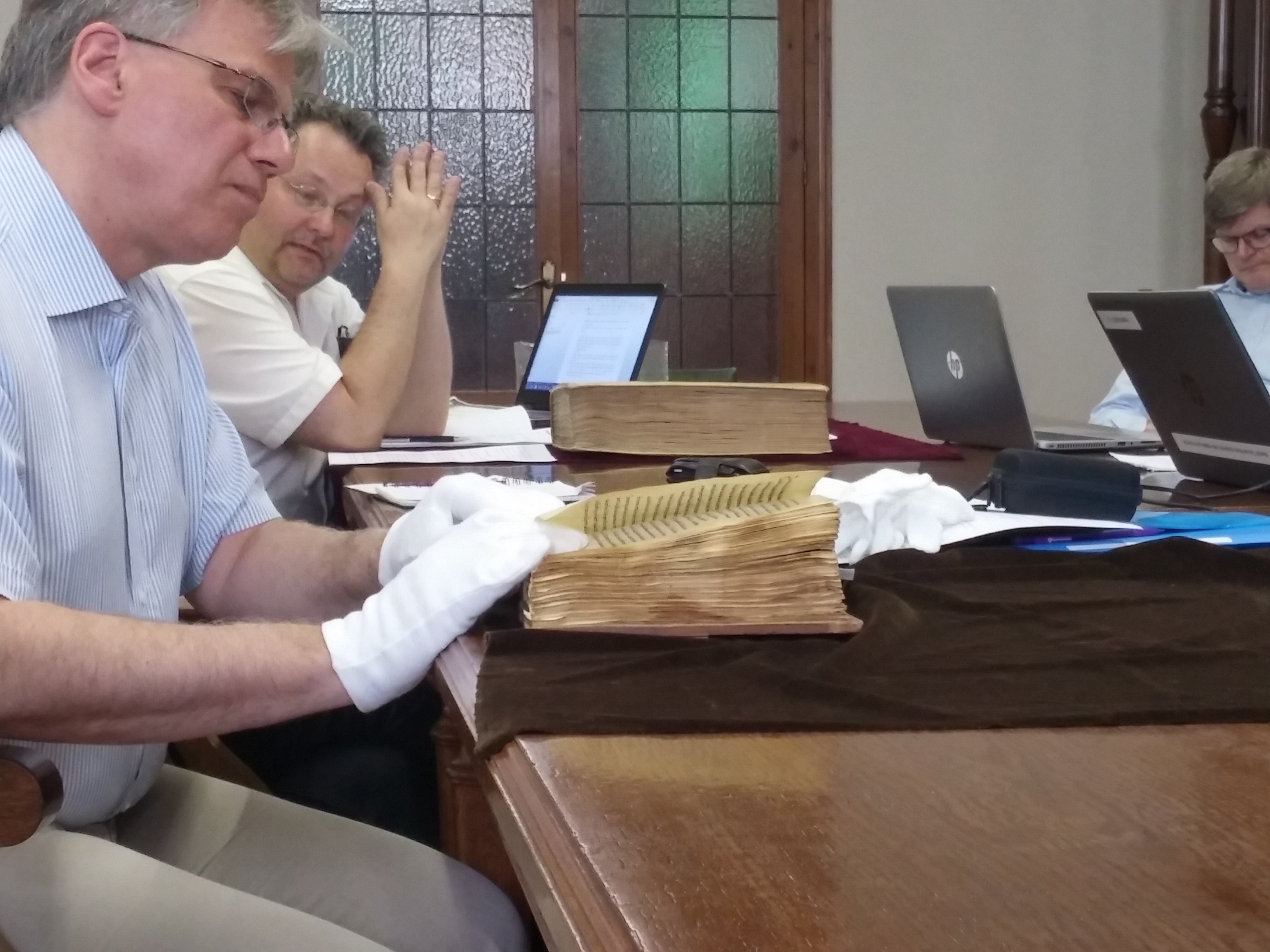 Stefan Esders discussed the manuscript El Escorial, Real Biblioteca del Monasterio de San Lorenzo, Ms. Z. II. 2. (an edition is available online), the only extant full copy of the Liber iudicum popularis is written in 1011 by a cleric and judge called Bonhom. Esders’ discussion made clear that legal manuscripts like these made extensive use of the past. The Frankish rulers are presented as the natural successors of the Visigothic kings (fol. 6r/v), and the so-called prologue to the Bavarian law code, originally written by Isidore of Seville and enriched by the Frankish rulers, provides a historical narrative of legislation starting with Moses and ending with the Merovingian kings as lawgivers (fol. 10r). Other interesting features are the Martyrology with saints from Barcelona (fol. 20r); the arbor sanguinitatis (fol. 96v), part a treatise on genealogy to prevent incest; the anti-Jewish professio iudeorum (fol. 252r); and a legal glossary (fol. 265r ff). The latter glossary clearly shows how the manuscript was conceived as a whole and was also intended to be used as such. This manuscript would continue to have an important influence on the development of medieval law in Catalonia, as fragments of several copies of Bonhom’s work have survived; one of which, preserved in Vic today, will be discussed below.
Stefan Esders discussed the manuscript El Escorial, Real Biblioteca del Monasterio de San Lorenzo, Ms. Z. II. 2. (an edition is available online), the only extant full copy of the Liber iudicum popularis is written in 1011 by a cleric and judge called Bonhom. Esders’ discussion made clear that legal manuscripts like these made extensive use of the past. The Frankish rulers are presented as the natural successors of the Visigothic kings (fol. 6r/v), and the so-called prologue to the Bavarian law code, originally written by Isidore of Seville and enriched by the Frankish rulers, provides a historical narrative of legislation starting with Moses and ending with the Merovingian kings as lawgivers (fol. 10r). Other interesting features are the Martyrology with saints from Barcelona (fol. 20r); the arbor sanguinitatis (fol. 96v), part a treatise on genealogy to prevent incest; the anti-Jewish professio iudeorum (fol. 252r); and a legal glossary (fol. 265r ff). The latter glossary clearly shows how the manuscript was conceived as a whole and was also intended to be used as such. This manuscript would continue to have an important influence on the development of medieval law in Catalonia, as fragments of several copies of Bonhom’s work have survived; one of which, preserved in Vic today, will be discussed below.
Esders then moved on a to a second manuscript: Barcelona, Biblioteca de Catalunya, Ms. 944, written in the tenth and eleventh century. This manuscript is a compilation of several texts: it contains the De divinis officiis by Amalar of Metz, an ordo Romanus, several synodal acts, a miracle of Jerome in Bethlehem, the celebration of the feast of Peter and an abbreviated version of Visigothic ecclesiastical law texts, based on the Collectio Hispana. The compilation is very much oriented towards Rome, as it contains the famous letter by pope Gregory VII addressed to bishop Hermann of Metz written by later hand. Esders suggests that the law texts in this manuscript are a bit more “down to earth” than more standard editions of Visigothic law texts. The abbreviated Visigothic law texts also reveal how Catalan elites attempted to conserve the Visigothic tradition while also introducing Carolingian texts. It thus marks a transitional stage from Visigothic law to local customs.
Matthias M. Tischler gave the final presentation of the morning by introducing us to the manuscript Barcelona, Biblioteca de Catalunya, Ms. 548. This manuscript contains the commentary of the gospel of Matthew by Remigius of Auxerre. It was written in the first half of the eleventh century and is of Italian origin. The calendar mainly contains Roman saints. The manuscript contains several fascinating layers of glosses from the thirteenth century onwards, which show that the manuscript was used during a considerable period: they were added over a period of three or four centuries!
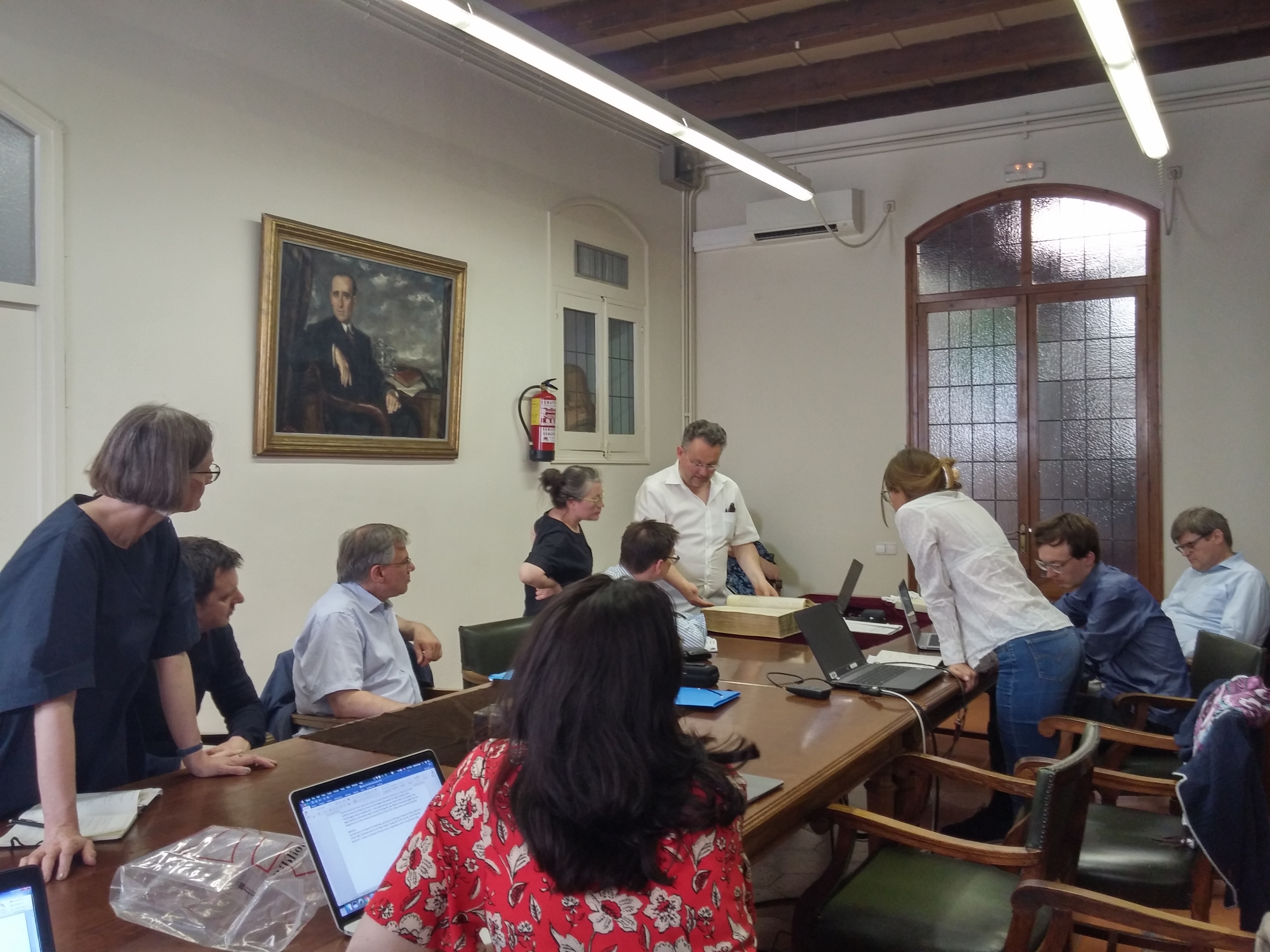
Friday May 25th – Afternoon
Location: Arxiu de la Catedral, Reading room
Presentations by: Sumi Shimahara, Matthias M. Tischler
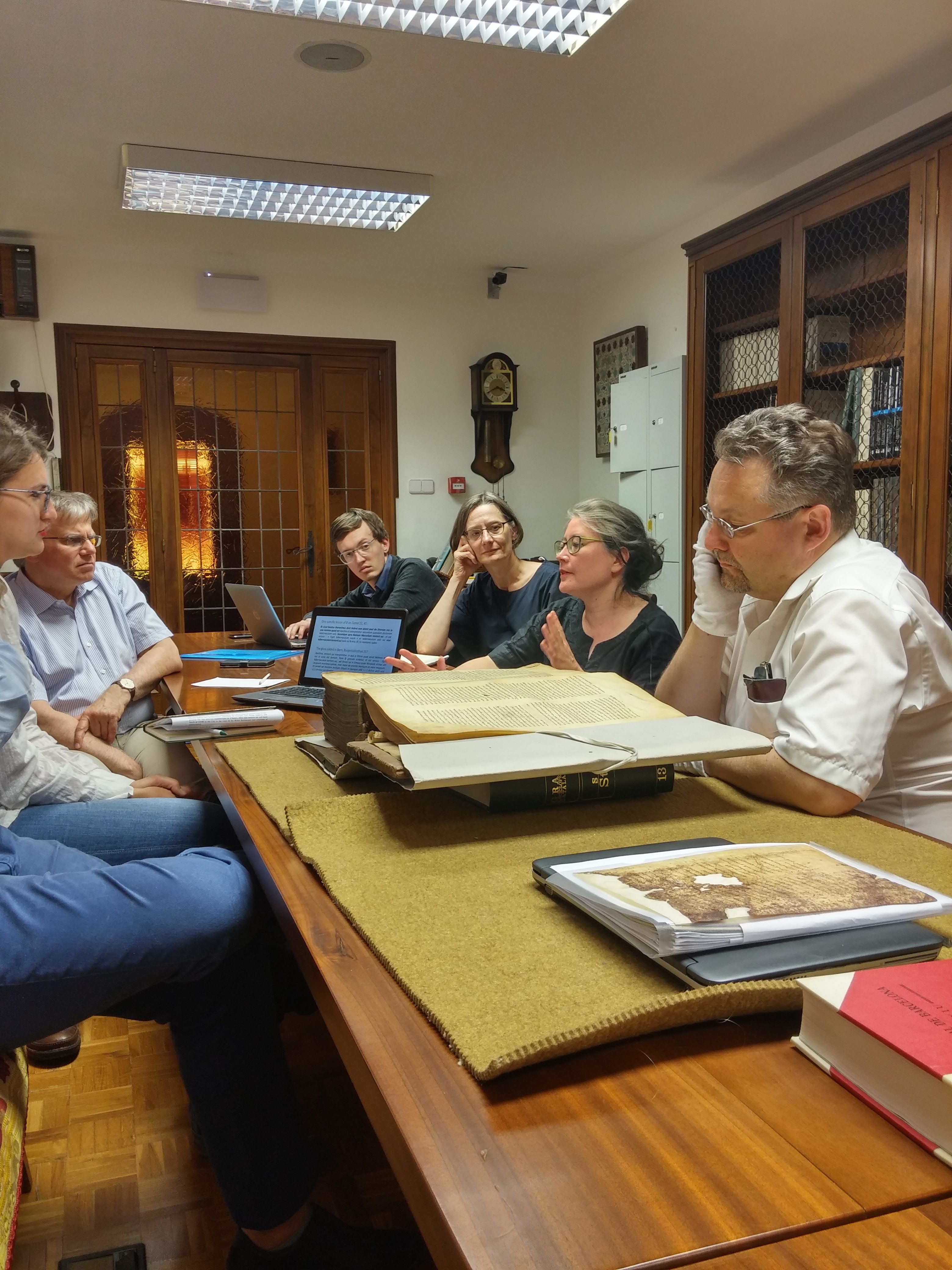
Sumi Shimahara showed us a beautiful manuscript from the Auxerre school. (Barcelona, Arxiu Capitular, Còdex 64). It is a large manuscript with 41 quires, containing texts by Alcuin and Rabanus Maurus. It also includes a number of anonymous texts, which need further exploring. The corrections may have been made by Haimo of Auxerre himself. The manuscript was in Catalonia at least from the thirteenth century onwards. The aim of the manuscript seems to have been to give a relatively brief exegesis of the Old Testament. In closing, Shimahara suggested that the manuscript can be seen as part of an early stage in the reworking of the Carolingian heritage.
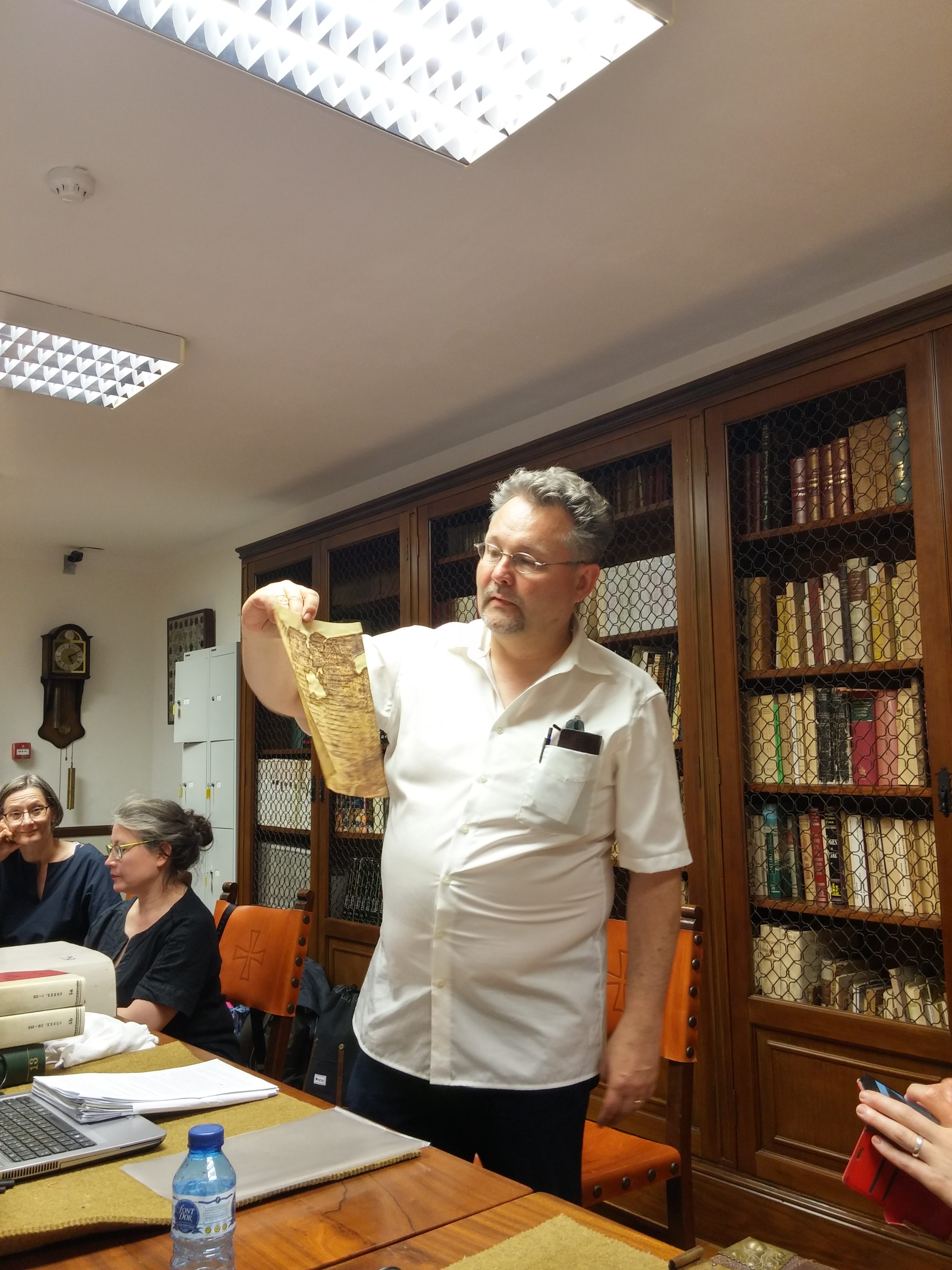
Matthias M. Tischler then discussed a folium of a glossary of the Benedictine Rule, here on c. 5 to 7, thus on the spiritual core of the text; this fragment is not mentioned in Bernhard Bischoff’s Catalogue of the manuscripts of the ninth century (Barcelona, Arxiu Capitular, Còdex 120, fragment no. 2) These glossaries were typical works of the new Carolingian exegesis of the basic text of Benedictine life. The Barcelona copy is from the later ninth-century Septimania or Catalonia, which makes it a valuable new testimony of the introduction of the Carolingian Benedictine reform in Southern France or the Spanish March respectively.
Besides these presentations, the group had a thorough look at two other manuscripts. The first one was an eighth-century Uncial manuscript containing the Homilies of Gregory (Barcelona, Arxiu Capitular, Còdex 120). The manuscript has fascinating marginal signs, including elaborate marks indicating the new quire and heart-shaped decoration. The second manuscript was the first volume of the thirteenth-century Cartulary of Barcelona Cathedral with copies of Carolingian charters at the beginning of the manuscript (Barcelona, Arxiu Capitular, Liber Antiquitatum I).

Saturday May 26th
Location: Vic, Arxiu i Biblioteca Episcopal
Presentations by: Stefan Esders, Ekaterina Novokhatko, Sarah Hamilton
Stefan Esders: Vic, ABE, Dipòsit MSG s. n. and Vic, ABE Ms, fragm. XV/3
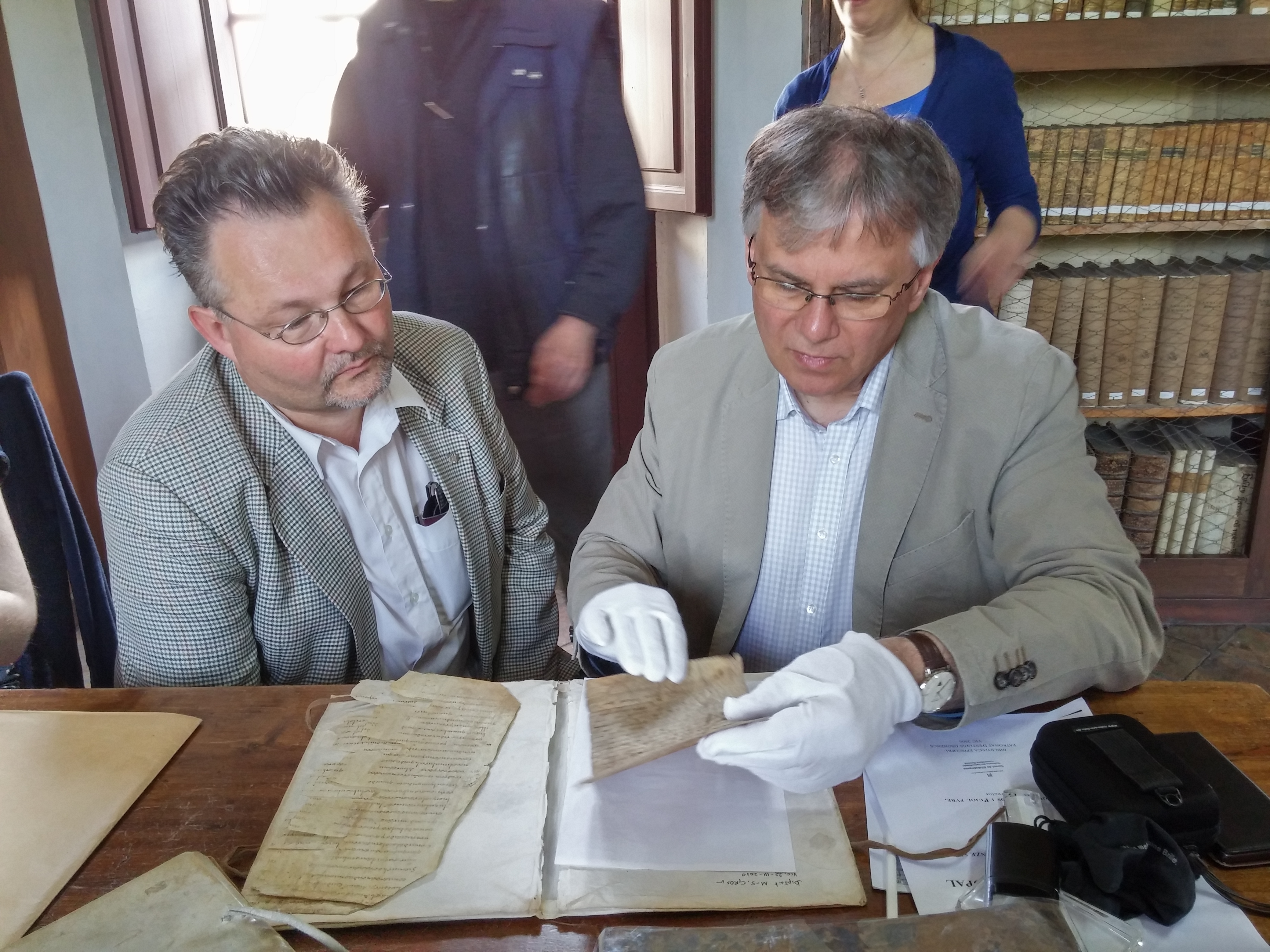 The first shelfmark contains two fragments with Visigothic law from around 900. It is difficult to place the fragment, as a few centimetres of the folio are cut off, and there is no numbering. Matthias M. Tischler indicated that the Carolingian script of this fragment shows the Visigothic substrate of the older book culture of north-eastern Spain.
The first shelfmark contains two fragments with Visigothic law from around 900. It is difficult to place the fragment, as a few centimetres of the folio are cut off, and there is no numbering. Matthias M. Tischler indicated that the Carolingian script of this fragment shows the Visigothic substrate of the older book culture of north-eastern Spain.
The second fragment with the Liber iudicum popularis of Bonhom, was written in the eleventh century and contains the same work discussed in the Escorial manuscript in Biblioteca de Catalunya the previous day. The lay-out is organised in such a way that it is prepared for marginal commentaries. The common features of lay-out and content suggest that there was a wish to spread and standardise the law codes.
Ekaterina Novokhatko: Vic, ABE, Ms. X/6 and Vic, ABE, Ms. 44.
 Vic, ABE, Ms. 44 contains an astrological compendium of Isidore of Seville’s works and the Regula canonica Aquisgranensis. The colophon on folio 84 allows us to date the manuscript to 1064. Besides, both (the fragment and the manuscript) contain the Apparitio archangeli Michaelis in Monte Gargano, a text used at the feast of St Michael. The text as well as the legend have an Italian origin, and Novokhatko found other copies of the same texts from Vic and Ripoll. The fragment X/6 with the provenance of a parochial church in the diocese of Vic may contain a direct copy of the Apparitio Michaelis from Ms. 44 (originating from the cathedral chapter of Vic). It is a fragment from a passionary containing the Invention of the Holy Cross on its recto side. Another fragment from Vic XXIV/4, represents another version of the Apparitio Michaelis, that is much closer to folio 156v from Barcelona ACA Ms. 74 (discussed on the first day of the workshop by Philippe Depreux). This dissemination of the Gargano legend shows the strong Italian influence and allows us to build a stemma of different versions circulated in the Catalan region during the tenth and eleventh centuries.
Vic, ABE, Ms. 44 contains an astrological compendium of Isidore of Seville’s works and the Regula canonica Aquisgranensis. The colophon on folio 84 allows us to date the manuscript to 1064. Besides, both (the fragment and the manuscript) contain the Apparitio archangeli Michaelis in Monte Gargano, a text used at the feast of St Michael. The text as well as the legend have an Italian origin, and Novokhatko found other copies of the same texts from Vic and Ripoll. The fragment X/6 with the provenance of a parochial church in the diocese of Vic may contain a direct copy of the Apparitio Michaelis from Ms. 44 (originating from the cathedral chapter of Vic). It is a fragment from a passionary containing the Invention of the Holy Cross on its recto side. Another fragment from Vic XXIV/4, represents another version of the Apparitio Michaelis, that is much closer to folio 156v from Barcelona ACA Ms. 74 (discussed on the first day of the workshop by Philippe Depreux). This dissemination of the Gargano legend shows the strong Italian influence and allows us to build a stemma of different versions circulated in the Catalan region during the tenth and eleventh centuries.
Sarah Hamilton: Vic, ABE, Ms. 66
This Sacramentary mentions 1038 as the year of the dedication of the church, which allows us to date it to the early eleventh century. It is a mixed Hadrianum-sacramentary without much unexpected content. The holy masses for the sick and the dead are accompanied with neums. At the end, presented as an appendix, there is a penitential ordo: the prologue to the penitential of Theodore, without the actual penitential. This penitential therefore clearly shows how Carolingian penitential culture influenced a Catalan manuscript.
Having discussed the manuscripts on the table and consulted them together, we received a spectacular guided tour around the archives of the episcopal library and archives of Vic. A continuous preservation of documents from the tenth-century onwards produced no less than 3.5 kilometres worth of archive. The absolute highlights were the tenth-century papyri rolls with charters issued by various popes, including one with the autograph signature of Emperor Otto III.

Concluding remarks
Much like the papyri rolls issued by the pope and signed by Otto III, the synergy event as a whole made clear how connected post-Carolingian Catalonia was to a wider European culture. The discussed manuscripts show above all the richness and plurality of this interaction between Catalonia and other cultural centres. We have seen how local abbots and bishops showed interest in decidedly Carolingian debates on the authority of kings over bishops, and in exegetical texts by Carolingian luminaries such as Haimo of Auxerre. A manuscript containing law texts effectively shows how Catalan cultural centres sought to integrate their region into a broader framework of Frankish history, while a later legal manuscript suggests a lively interaction between local law traditions and external influences. There were also clear connections between the region and Italy. The synergy event has thus shown that although Catalonia was peripheral to the Carolingian world geographically, it played a central role in the lively dissemination of Carolingian culture in a post-Carolingian world.

